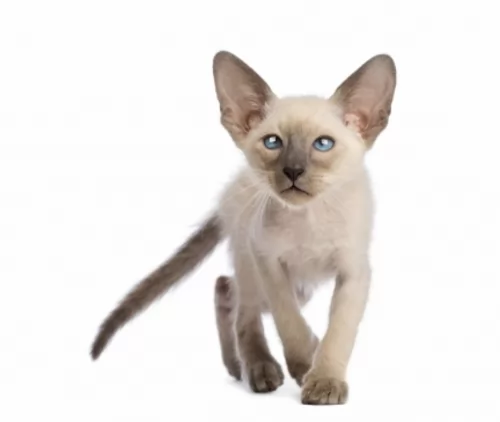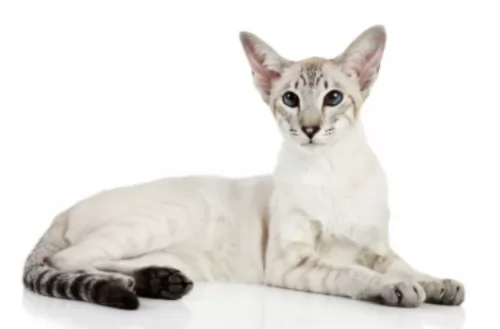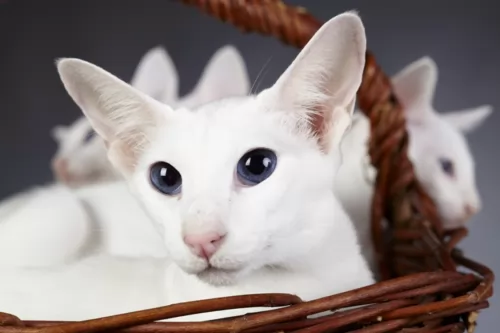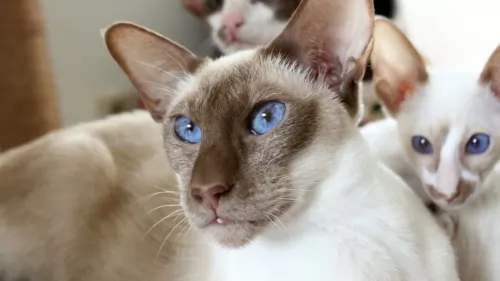 Petzlover
Petzlover Colorpoint Shorthair is originated from United Kingdom but Traditional Siamese is originated from Thailand. Both Colorpoint Shorthair and Traditional Siamese are having almost same weight. Colorpoint Shorthair may live 4 years less than Traditional Siamese. Both Colorpoint Shorthair and Traditional Siamese has same litter size. Colorpoint Shorthair requires Low Maintenance. But Traditional Siamese requires Moderate Maintenance
Colorpoint Shorthair is originated from United Kingdom but Traditional Siamese is originated from Thailand. Both Colorpoint Shorthair and Traditional Siamese are having almost same weight. Colorpoint Shorthair may live 4 years less than Traditional Siamese. Both Colorpoint Shorthair and Traditional Siamese has same litter size. Colorpoint Shorthair requires Low Maintenance. But Traditional Siamese requires Moderate Maintenance
 The Colorpoint Shorthair is a Siamese cat that came about when the Siamese cat was used with the red American Shorthair to bring about new colors.
The Colorpoint Shorthair is a Siamese cat that came about when the Siamese cat was used with the red American Shorthair to bring about new colors.
The actual name is given by the CFA or Cat Fanciers’ Association to refer to pointed cats that have Siamese parents and that have many colors other than the usual 4 Siamese colors which are blue, lilac, seal, and chocolate.
It was in the 1940s and 1950s that cat breeders in the UK and the USA wanted to develop a Siamese cat with red points as opposed to the traditional Siamese colors. It was in 1964 that these red and cream Colorpoint Shorthairs were awarded championship status with the Cat Fanciers’ Association.
Today, different cat registries recognize the Colorpoint Shorthair as a separate breed while others see it as a variation of the Siamese.
 There are now three types of Siamese cats. The Traditional Siamese is said to be the original cat imported from Thailand.
There are now three types of Siamese cats. The Traditional Siamese is said to be the original cat imported from Thailand.
The Classic was the type that was common in the 50’s, 60’s and 70’s. The original Siamese cat became one of the most popular breeds in Europe and North America in the 19th century.
 The Colorpoint Shorthair is a medium-size cat that typically weighs between 2 to 4kg and is nicely muscled. This is a long cat with legs that are long and slender too.
The Colorpoint Shorthair is a medium-size cat that typically weighs between 2 to 4kg and is nicely muscled. This is a long cat with legs that are long and slender too.
The coat is short and glossy, light-colored with darker extremities. Colors can be Cream Point, Red Point, Cinnamon Point, Seal Point, Blue-, Lilic- and Chocolate Point among others. The cat is well known for its mesmerizing almond-shaped blue eyes.
This sweet agile, athletic cat will be a delight in your home as he is highly intelligent and can easily learn a few basic commands but he is also friendly, playful, and loving. They’re social, outgoing cats too and when he’s not amusing himself, he will happily come and lounge about close to where his beloved human companions are.
On the other side of the coin, these cats can also be somewhat nervous and sensitive and they won’t adapt easily to a change in environment and lifestyle. It is why you have to choose your pet carefully and understand that owning a pet is a commitment of some 15 years or so.
Like the Siamese cat, these felines can be very vocal and they let you know when they want your attention.
 The Traditional Siamese cat is medium-sized, lean, and muscular and weighs between 3 and 6kg. The coat is short and he is considered a medium shedder.
The Traditional Siamese cat is medium-sized, lean, and muscular and weighs between 3 and 6kg. The coat is short and he is considered a medium shedder.
The kittens of these cats are born white and the coloring comes in over the next days and weeks. The head of the Traditional Siamese is well proportioned to its body size.
The medium size ears are slightly rounded at the tip and the eyes are large and bright blue in color.
The coat is short, sleek, and soft and accepted colors are cream with chocolate, brown, lilac, red, tortie or blue points.
The personality of the Traditional Siamese is loud, vocal, and demanding. These cats let you know precisely what they want and it is almost like having a human companion in the house.
They love to give their human owners lots of attention as well. They’re intelligent, curious, playful, and energetic.
The Traditional Siamese cat isn’t really recognized by the Cat Fanciers Association (CFA) anymore as the breed’s temperament has changed so much.
 Choose the wonderful Colorpoint if you want a cat that isn’t cold and independent. With this cat you have one that is more like a companion and looks forward to being around you.
Choose the wonderful Colorpoint if you want a cat that isn’t cold and independent. With this cat you have one that is more like a companion and looks forward to being around you.
This is a loyal and loving cat who wants to be part of the human family and he wants to be involved in your life.
He suits first-time cat owners, those with children and pets in the home as well as being an excellent pet for seniors – anyone in fact, who is willing to bestow on him the love and affection he craves.
 The Traditional Siamese cat is such an amazingly intelligent animal and sometimes they can become quite human.
The Traditional Siamese cat is such an amazingly intelligent animal and sometimes they can become quite human.
These are not your traditional cool, independent, sleep all day kind of felines and people liken them to having a dog as a pet. They love to play, and they are so active you could even put a leash on one and take it for a walk.
They are energetic, local, and lively. They are such affectionate cats too and they get on well with children and with other pets.
When you bring a Traditional Siamese cat into your life, it is like you are bringing in a human companion, except that the Traditional Siamese is far more amicable than many humans.
 When it comes to the health of these beautiful cats, you may well find similar health issues as what affects the Siamese, some of which are asthma or bronchial disease, congenital heart defects and lymphoma among others.
When it comes to the health of these beautiful cats, you may well find similar health issues as what affects the Siamese, some of which are asthma or bronchial disease, congenital heart defects and lymphoma among others.
Lymphoma is cancer in the lymphocyte cells. Your cat will be lethargic and you will need to get him to the vet and provide the vet with a medical history of your cat. Lymphoma is believed to be associated with exposure to feline leukemia virus as well as the feline immunodeficiency virus.
 Avoid obesity. Siamese cats are prone to obesity and these slim cats can’t afford weight gain. Extra weight can put a whole lot of pressure on the cat’s joints and they can also develop other problems such as diabetes. The label of the commercial cat food you give your Traditional Siamese will indicate how much food your cat should get a day based on your cat’s weight.
Avoid obesity. Siamese cats are prone to obesity and these slim cats can’t afford weight gain. Extra weight can put a whole lot of pressure on the cat’s joints and they can also develop other problems such as diabetes. The label of the commercial cat food you give your Traditional Siamese will indicate how much food your cat should get a day based on your cat’s weight.
Diet plays a massive role in the health of a cat, and inferior cat foods can mean you spending more money at the vet because of digestive issues.
If you are in any kind of doubt as to what to feed your cat, rather speak to your vet about what and how much to feed him. Your cat is a carnivore and it is most important to feed your cat foods high in protein.
Take your cat to the vet whenever he is sick and also just for a general check-up. You want to make sure that your Traditional Siamese is free from any health problems as well as parasites.
Also, make sure your cat is always up to date with his vaccinations as there are some cat illnesses such as feline panleukopenia, also known as distemper, that can kill your cat.
It is always a good idea as well to spay or neuter your Siamese to prevent unwanted pregnancies.
If your Traditional Siamese has any health conditions, your vet can help provide you and your pet with a treatment program.
 Rember that your Colorpoint Shorthair is a long, lean, musculac cat and for health purposes, you want to ensure a good diet of the best cat food there is. There are some excellent commercially manufactured cat goods available and it is wise to get to know the ingredients as meat and protein is high on the list. Cats are carnivoes and it is imperative to feed your cat high quality protein. When in any kind of doubt, speak to your vet about the best cat food available for your special feline friend.
Rember that your Colorpoint Shorthair is a long, lean, musculac cat and for health purposes, you want to ensure a good diet of the best cat food there is. There are some excellent commercially manufactured cat goods available and it is wise to get to know the ingredients as meat and protein is high on the list. Cats are carnivoes and it is imperative to feed your cat high quality protein. When in any kind of doubt, speak to your vet about the best cat food available for your special feline friend.
The short coat requires brushing once a week.
Check your cat over for any unusual lumps. Look at his eyes, check inside his ears for signs of redness and infection and check inside his mouth for signs of bad teeth as this can cause him terrible pain.
Provide a litter box and keep it scrupulously clean.
Have your cat spayed or neutered to avoid unwanted kittens and to also promote better health for your cat.
Provide your cat with a warm bed, food and water bowls, and stimulating toys.
 To care for your Traditional Siamese, you need to feed him a high protein diet. Always read the labels of the cat food you buy to ensure that the proteins included come from animal sources and not from plants.
To care for your Traditional Siamese, you need to feed him a high protein diet. Always read the labels of the cat food you buy to ensure that the proteins included come from animal sources and not from plants.
Brush your Traditional Siamese cat regularly. He has a short coat so once a week will be enough to keep it shiny and clean.
You can feed your cat and provide all he needs, but nothing will be more important to your cat than showing your love for him by spending lots of time with him and showering him with love.